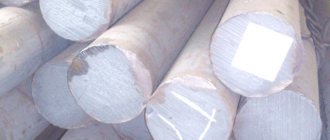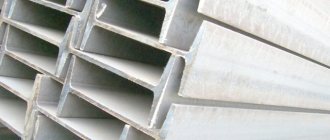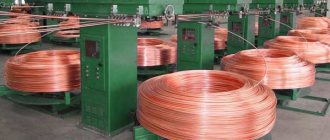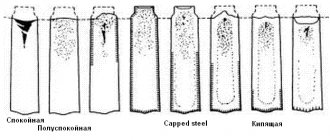STATE STANDARD OF THE USSR UNION
| ORDINARY QUALITY CARBON STEEL Brands and general technical requirements Carbon steel of ordinary quality. Types and general technical requirements | GOST 380-71* Instead of GOST 380-60 |
By Resolution of the State Committee of Standards of the Council of Ministers of the USSR dated April 6, 1971 No. 692, the introduction date was established
from 01.01.72
Failure to comply with the standard is punishable by law
This standard applies to carbon steel of ordinary quality: hot-rolled - sectional, shaped, thick-sheet, thin-sheet, broad-band (universal) and cold-rolled - thin-sheet, and, in terms of chemical composition standards, also to ingots, blooms, slabs, rounds, rolled and cast billets from plants continuous casting of steel, pipes, forgings and stampings, strip, wire and hardware.
The standard does not apply to steel produced by the Bessemer process.
The standard takes into account the requirements of the CMEA recommendation on standardization PC 1-70.
Stamps
1.1. Depending on the purpose, steel is divided into three groups:
A - supplied according to mechanical properties;
B - supplied according to chemical composition;
B - supplied according to mechanical properties and chemical composition.
1.2. Depending on the standardized indicators, steel of each group is divided into categories:
groups A - 1, 2, 3;
groups B - 1, 2;
Groups B - 1, 2, 3, 4, 5, 6.
Note. These categories do not apply to steel with a thickness of less than 4 mm.
1.3. Steel is produced in the following grades:
groups A - St0, St1, St2, St3, St4, St5, St6;
Group B - BSt0, BSt1, BSt2, BSt3, BSt4, BSt5, BSt6;
Group B - VSt1, VSt2, VSt3, VSt4, VSt5.
1.4. Steel of all groups with grade numbers 1, 2, 3 and 4 according to the degree of deoxidation is produced boiling, semi-calm and calm, with numbers 5 and 6 - semi-calm and calm.
Semi-quiet steel with grade numbers 1 - 5 is produced with normal and high manganese content.
Steel grades St0 and BSt0 are not distinguished by the degree of deoxidation.
pp. 1.2
—
1.4.
(Changed edition, IUS 6 -
74).
1.4.1. The degree of deoxidation of all groups is selected by the manufacturer, if it is not specified in the order.
1.5. Steel grades VSt1, VSt2, VSt3 of all categories and all degrees of deoxidation, including with a high content of manganese, and at the request of the customer, steel grades BSt1, Bst2, BSt3 of the second category of all degrees of deoxidation, including with a high content of manganese, are supplied with a guarantee of weldability.
(Changed edition, IUS 6
—
74).
1.5.1. Weldability is ensured by manufacturing technology and compliance with all chemical composition requirements for steel of groups B and C.
1.5.2. The supply of group B steel with a guarantee of weldability is specified in the order and in the certificate.
1.5.3. Steel with a carbon content in the finished product of more than 0.22% is used for welded structures under welding conditions that ensure the reliability of the welded joint.
pp. 1.5.1 - 1.5.3. (Changed edition, IUS 6-74).
1.6. The designation of steel grades when ordering, branding, in a certificate, on drawings and in other documentation is alphanumeric.
1.6.1. The letters St mean “steel”, numbers from 0 to 6 are the conditional number of the brand depending on the chemical composition of the steel and mechanical properties, for example: St0, St1, St2, St3.
1.6.2. The letters B and C in front of the brand designation indicate the steel group; group A is not indicated in the steel grade designation, for example: BSt3, VSt3, St3.
1.6.3. To indicate the degree of deoxidation, indices are added to the designation of the steel grade after the grade number: kp - boiling, ps - semi-quiet, sp - calm, for example: St3kp, St3ps, St3sp, BSt3sp, VSt3sp.
1.6.4. To designate a steel category, the number of the corresponding category is added to the brand designation at the end, for example: St3ps2, BSt3kp2, VSt4ps2.
1.6.5. The first category is not indicated in the steel grade designation, for example: BSt3kp, VSt3ps.
1.6.6. When ordering steel of the required category without indicating the degree of deoxidation in the designation of the steel grade, the grade number and category are separated from each other by a dash, for example: St3-2, BSt3-2.
1.6.7. To designate semi-mild steel with a high manganese content, the letter G is added to the designation of the steel grade after the grade number, for example: St3Gps, VSt3Gps, VSt3Gps3.
1.6.8. When branding, it is allowed to use letters and numbers of the same height.
When hot stamping rolled steel, the steel marking may be indicated without indicating the group and category of steel and indicating them in the certificate. Groups and categories of steel are applied by agreement of the parties.
(Changed edition, IUS 6-74).
1.6.9.
(Excluded, IUS 6-74).
1.6.10. Steel grade BSt3sp (in ingots and slabs), intended for rolling into sheet metal, supplied under group B categories 4 - 6, must meet the requirements of clause 2.4.5.
(Introduced additionally, IUS 6-74).








